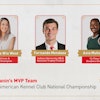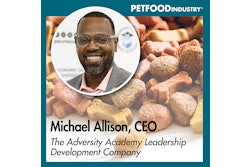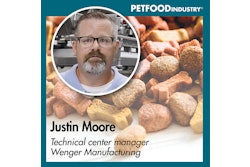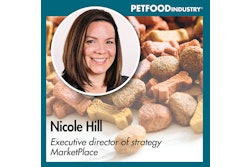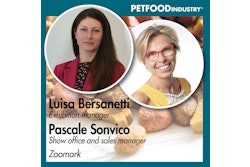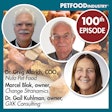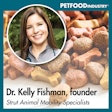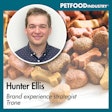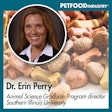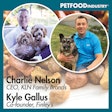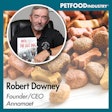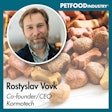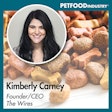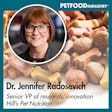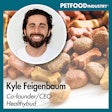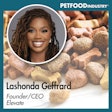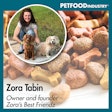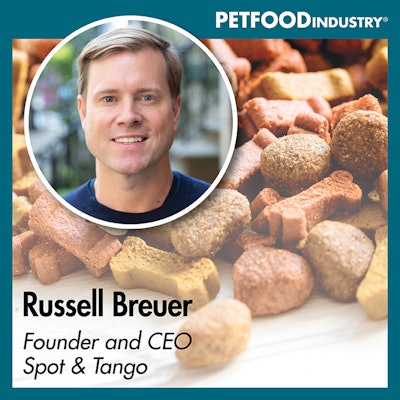
In this episode of Trending: Pet Food, host Lindsay Beaton and Russell Breuer, founder and CEO of Spot & Tango, focus on hero products -- a company's flagship product, considered the standout offering that best embodies the brand's identity and values. They delve into how these products can help your brand’s continuous evolution and innovation to adapt to changing consumer demands.
The below transcript is from Episode 81 of the Trending: Pet Food podcast, where host Lindsay Beaton and Russell Breuer, founder and CEO of Spot & Tango, discuss hero products that you can build your brand around. You can find the episode at Trending: Pet Food Podcast, on SoundCloud or on your favorite podcast platform. This episode originally aired on February 25, 2025.
We want to thank AFB International for sponsoring this podcast. AFB is the premier supplier of palatants to pet food companies worldwide offering off-the-shelf and custom solutions that make pet food treats and supplements taste great.
Lindsay Beaton, editor, Petfood Industry magazine and host, Trending: Pet Food podcast: Hello, and welcome to Trending: Pet Food, the industry podcast where we cover all the latest hot topics and trends in pet food. I’m your host and editor of Petfood Industry magazine Lindsay Beaton, and I’m here today with Russell Breuer, founder and CEO of Spot & Tango. Hi Russell, and welcome!
Russell Breuer, founder and CEO of Spot & Tango: Hi, Lindsay. Great to be here. Thanks for having me on.
Beaton: In case you’re unfamiliar with Russell or Spot & Tango, here’s what you need to know.
Russell Breuer is the CEO and Founder of Spot & Tango, a digitally-native pet health & wellness company on a mission to bring fresh, human-grade food to dogs across the country. Prior to founding Spot & Tango, he spent 14 years working in consulting and private equity, most recently for Berchwood Partners and Zephyr Management with a focus in the oil & gas, aerospace & defense, and consumer sectors. He holds a BA in International Studies and Spanish from Emory University.
Spot & Tango is an innovative pet health and wellness brand focused on providing dogs with the highest quality, human grade meals excluding artificial additives, fillers, and preservatives commonly found in commercial kibble. Developed by a team of leading animal nutritionists, Spot & Tango personalizes its meal plans specific to a dog’s weight, activity level, and lifestyle, delivered direct-to-consumer in eco-friendly packaging.
Russell’s business experience, not the least of which is founding a successful company in the pet food space, is why I’ve brought him on today and answer this question: How can having a “hero product” help a pet food company thrive?
Russell, I want to start out with a bit of a 101, just so that we are all on the same page. What exactly is a hero product?
Breuer: Great question. We talk about it often in our business, a hero product or a hero image. In our experience, a hero product is something that has found rapid product market fit. In other words, the demand and the interest from consumers is of greatest interest in that specific product or even service, versus potentially other products or services in your portfolio.
In our experience at Spot & Tango, we launched a fresh, frozen recipe in the early days. Those are the original recipes for the business, which were in very high demand. We identified a market opportunity. We’re big believers that pet health and wellness is a right, not a luxury, so we really found something that people identified with.
People were feeding their dogs fresh, human-grade ingredients that are “for you” products, and that product resonated with the consumers. That was product market fit and identified demand for a product. We can talk later, but ultimately, we launched another product called UnKibble, which is the benefits of fresh and the convenience of dry food. We call it a fresh dry product, and that's a different level of product market fit.
Now, our hero product, where not only was there a great product demand, but I would say, escape velocity of the business, where there was a much greater product market fit in terms of really identifying the needs of the consumer and meeting those needs with a product that was better for their dogs as well.
Beaton: Can your hero product change from what you initially intend as you go along and find that maybe another product is a better fit or more of an anchor point for your brand?
Breuer: Absolutely. I think you've seen that in other examples in the consumer space. You know, what comes to mind are brands like Apple, who are consistently innovating across the spectrum. Obviously, the iPod was at the time, their hero product, then the iPhone emerged. Everything in life is a natural evolution. I think all businesses are constantly seeking to innovate to meet ever changing consumer demand and interest.
If you think back to playbook 101 of CPG, innovate or die. If you're not thinking rapidly about how your business and the products meet the needs of the consumer, you won't be successful. I think in our case, we've moved from fresh frozen onto kibble, and we have both categories.
We sell both categories of products even today, but we were introspective in terms of what exactly is it that meets that consumer demand and we benefit. Because we are a direct-to-consumer business, we listen to our consumers and our customers, and they tell us exactly where there are pain points. They tell us where there are opportunities. They tell us what their interests are, and we continually innovate and iterate on the base food offering that we have and those products. We’ve launched new products in addition to food. So again, I think it's absolutely the answer is there are evolving needs, and businesses need to adapt to those needs over time.
Beaton: Let’s dive into that a little bit more, because I want to discuss how a company can go about determining or defining its hero product. Obviously, not every company is direct-to-consumer, but every company these days has some kind of communication line to its consumers.
How much of the conversation when you're trying to figure out what your hero product might be, is strictly internal? How much, or at what point do you go external to your consumers to try to figure out what they might consider your flagship product to be?
Breuer: I think internal ideation, secondary or desktop research, is very important, right? Virtually, when you're starting to formulate ideas, it's getting signals from the marketplace -- inspiration from potential competitors, inspiration from adjacent categories.
Looking at consumer research in terms of buying behavior, geographic behavior, demographic behavior, you can learn a lot about what's going on and potentially start to identify patterns. It's called pattern recognition of things that potentially could be a fit.
I think that's always useful to inform a base layer of understanding, and ultimately, you need to overlay your ability to execute as a business on some of those ideas.
Certainly, there are some farfetched ideas that we've had that could potentially be the best product ever, but certainly not feasible from a commercial perspective. I think you need to ground yourself, and then, crucially, the next step in the process is to solicit feedback from your customer base. You can do that in a myriad of ways. Obviously, you can have conversations on the phone, you can do focus groups live. You can send out surveys. We do all of the above to get a pulse on what people think.
It’s also important that you solicit specific feedback. The types of questions we ask are not necessarily binary in nature. In other words, do you like product? Yes or no. The question is, if you like it. Why do you like it? What about the product do you like? What is the use case for this product? You could even propose price points. Would you purchase this product at these proposed prices? How does it make you feel? What other applications do you think this product could have in your day-to-day life?
The survey -- or the conversation -- really needs to inform decisions internally. Those types of inputs help make decisions. Then ultimately, when you get into a prototyping phase, and we're doing that now with an innovative dental care product, you need people to interact with the product early focus groups. At that early stage, it's like, “Let's touch and feel this product and actually better understand more about use case, more about how receptive people may be.”
You need to ensure the focus group are those people that you survey, that there's a wide enough spectrum, and that the N, which is effectively the number of people that you survey, is statistically significant.
In other words, I could send you, Lindsay, a product, and I could send my mother a product, and you could both agree and say, “This is fantastic.” But I'm leaving out a wide array of opinions from other genders, demographics, geographic, West Coast, North Central, to inform that decision.
You need to make sure that you are getting enough information from a spectrum of consumers to inform those types of decisions. It's a long-winded way of saying that there's a staged process, but very much rooted in internal to begin and then rigid, rigid exploration of the external factors and feedback.
Beaton: When you guys were initially going through this process for yourselves, were there any challenges or surprises that popped up throughout the process that was interesting?
Breuer: Yes. In our experience, the biggest challenge was production. We launched our UnKibble recipe in April 2020 and if you remember, that was a unique time in history. We had this thing called COVID and a pandemic on our doorstep.
So, we launched a product at that time. We were a very small business. I think we had less than 10 people on staff at the time, and we launched a product that we thought would last three to four months from an inventory perspective. We sold out in four days. This presented a unique challenge, which was, how do we make more quickly? Which is a wonderful problem to have, but if you can't supply demand, you don't have a business. For us, from a supply chain perspective, that was one of the greatest challenges that we experienced, and we had to rapidly innovate our supply chain to meet demand at that time, and that continues to be a focus point for our business.
Beaton: How in your experience has having a hero product throughout the company's evolution helped build up the company? What level of flexibility do you have to have in terms of using that hero product to build a brand around when it could very well change over the years as customers lock on to different products, or just the ebb and flow of commerce?
Breuer: That's an interesting question. For us, UnKibble is our North Star. We are very focused on that product category. No doubt consumers could get distracted or sure their attention could divert to other products. Ultimately, we take stock in the fact that we are primarily a dog food business. Dogs need to eat.
We are mission-driven business. To my earlier point, food or health and wellness is a right, not a luxury, and so we are very grounded in some very basic fundamentals about how the industry works and our deep care and interest in serving animals. We know that will never deviate.
If you look back at history and if you look at the trends now with the humanization of pets, we know that that demand will always be there for these types of products, and it's growing significantly.
Within pet, the consumer mindset and consumer trends have changed dramatically, even in the past 10 years. Ingredient transparency, very important. High quality, fresh ingredients, very important. People are taking a greater interest in their pets and their dogs, health and wellness. They're talking to vets about it, they're asking questions. They're asking all the right questions. There's a greater transparency, more now than ever in history, and a light shining on pet and that's important.
Back to your question. It's always important to remind yourself why this hero product exists. Defining a hero product to us is to ensure that we don't get too distracted. We love to innovate, because our customers are going to tell us wonderful products they would like to see, and we've addressed those needs through either launching supplements or specific treats.
But staying grounded in the fundamentals, I think, is important. Oftentimes brands get a bit over their skis, frankly, and try to launch too many products too soon, and that can confuse the customer and can detract from the brand. People will say, “Well, maybe that wasn't a hero product. I'm being served new content and new products.” That's a risk, and for us, we are laser focused on making UnKibble a success.
Beaton: This is a little bit off the main topic, but it's a very interesting one, and one we cover quite a bit on the podcast. How do you manage risk versus staying true to your original brand messaging, knowing that you know, if you take a risk and it's super successful, your brand messaging might have to change.
Breuer: That's a good question. That's very stage dependent. Earlier stage businesses need to take risks to be successful. Ultimately, you need to find product market fit ideal. You find a hero. Product revenue and growth comes alongside.
Part of starting a business is inherently risky. You're starting from nothing, from the ground up, like we did. There are many unknowns beyond just product. Even if you have a hero product, how do you make the hero product? How do you package it? How do you ship it? How do you scale the business?
From the HR and people perspective, there's a lot of macro questions that are difficult to answer. As companies grow and move to later stages, the risk profile changes. To my earlier point, once you have product market fit and you've established a solid foundation, you need to protect the foundation, so the risk profile changes.
Ultimately, innovation is an element of risk. There are many companies in history that have launched new, innovative products that don't succeed, but you'll recognize that many of those businesses aren't turning off here or products and substituting new ideas that are potentially unproven or untested. Successful businesses are focused on maintaining the foundation with incremental risk on top.
My answer is very much stage dependent. We've been through all the stages. We are a ground-up-built business, and the risk profile has ebbed and flowed over time. We've been doing this since 2018, so we've seen different flavors of risk. No doubt every business is exposed to risk. It’s mitigating and managing that, and it’s led to a stage I think, that’s important.
Beaton: As a smaller company, when you were looking for your hero product, what was the time and manpower commitment to that? That's a big conversation -- there are so many small- to mid-sized pet food companies in the industry with limited human capital -- they don't have huge budgets for marketing or the ability to put out studies or huge consumer outreach.
What did you focus on? What was that timeline like in terms of how long it took you to really feel like you had enough information and consumer data to work with?
Breuer: It took us about eight months to get UnKibble off the ground. There are less than 10 people working on it. I'd say 75% of the organization at the time was focused on it from a packaging, production, marketing, customer service, finance perspective. At that stage of the business, people wear multiple hats. You don't have dedicated functions, dedicated head count. Employees need to be all around athletes. One individual on our team focused on customer service is also leaning in on copy choice and marketing decisions. I was involved in packaging and production and finance, and my co-founder and CEO was also focused on a number of those topics as well, in addition to tech and websites.
Oftentimes it comes down to the people in the organization. Time is relative. Does it take 80 hours a week? 100 hours a week, or 20 hours a week? Ultimately, our goal at that time was to be thoughtful about how to stage the research process, product development process, go to market strategy.
It was a big lift, but we knew based on our experience in the category at that stage with our fresh frozen business, we knew considering some of the competitive activity, and we knew based on customer feedback, that – and this is a really key point -- UnKibble is 30% to 40% less expensive than any of the fresh-frozen players in the marketplace. That's huge.
We are selling affordable health and wellness -- that is huge. A lot of players in the fresh space, it's a wonderful product. Again, we still have fresh. They're wonderful products, but they can be cost prohibitive for many households, and they're not convenient. You need to store it in the freezer.
For us, it was, okay, there is a core pain point. How do we make a product that's more affordable, that's convenient? That’s UnKibble. It can be stored in your pantry. It's personalized. It's less expensive. Wow. That's why we've seen such demand for that. Again, a lot of that was consumer research and feedback from customer base.
But again, to your question, it's all hands-on deck. Companies need to embody that mentality. In the early stages, statistically, most businesses built from the ground up don't succeed. You need a lot of luck. You need grit, and I think crucially, persistence to get through anything.
Our team stepped up, and again, at a time when COVID was upon us. Back to hero product -- it was that product fit that helped shepherd us through some of those challenging times to be successful.
Beaton: Let's say a company's listening to this, and they're trying to think about their own hero product. Maybe they're realizing that, based on everything we've talked about, maybe their hero product isn't what they thought it was, or maybe it's just time to refresh their brand identity and perhaps looking into and ensuring that what you thought was your flagship product is still the primary focus of your company.
What advice do you have, first for a company that is looking to identify its first hero product, and then what advice do you have for a company that might be looking to shift its brand identity to help them not lose focus of that hero product and what it can do for your brand identity and for your company?
Breuer: I'd say fail fast. Fail often rapidly. Innovate rapidly. Test those products that don't resonate or don't grow quickly or are not in high demand. Turn off and iterate. Fail. Iterate, launch again.
For early-stage businesses, I think that's one of the key success factors. You must be nimble, and you must move quickly. It’s okay to fail. That's part of the process.
If you're pious about one product, and you put all your eggs in one basket, the chances for success can be limited. The key is to iterate. Being nimble is such a superpower. Getting together a very strong group of either a founding team or management team, use that to your advantage. There's not a lot of stakeholders in these businesses at that stage, and so it's all about speed. Fail fast, fail often.
Your question about later stage? Look, I think once you're there, it's kind of my earlier point, protect the base. Protect the foundation. Ultimately, a lot of brands pivot, and that's okay, too. Sometimes you do need to change the direction. Sometimes you do need a bit of a brand lift.
We rebranded our business in the early days. We'd gone through a rebrand in the last 18 months with new colors and copy and a better vision of who we are as a business. That’s okay. Change is good.
You’re not going to hit a home run on day one. It takes years to build these businesses, regardless of sector, regardless of category, it takes time, and it's okay to change tack. It's okay to launch products that are outside your wheelhouse and try to find that product market fit.
If you don't challenge yourself on the innovation that can be an issue in terms of longevity. Sometimes people get overly loyal to a product that may not be truly hero. They think it's good enough. If you don't see and read the signals in terms of demand and whatever your key performance indicators are, that can be very challenging. That would be my advice.
Beaton: What do you think is the best way to overcome that kind of reticence? If you start a company and you're very attached to a product, or you really think this is the image that you want to project, or this is your brand's identity. Then maybe you're getting signals from consumers that this is not the brand identity that you're projecting -- maybe they're latching on to another product -- how do you overcome what you see as the vision versus what the reality is, so that you can merge the two together successfully?
Breuer: I’d say humility. No one is ever always right. Humility is a strong value. And listen. There are so many occasions when people I work with will either have a differing opinion or a new idea, and I'm always very receptive to those ideas. Ultimately, at Spot & Tango, we test everything. In other words, on website or related to product or copy and so really, internally, no one's right.
It's the customer that will tell you what's right. Whether that's a color of a button that's on a website or a product. I think humility is one key characteristic of founders or founding teams that's important. Then testing and iterating and using those tests to inform direction, I think is also important.
Oftentimes, people live in a bubble and think, “Oh, this is it.” And they look around, everyone on the team is excited. We think this is the right direction. But the team may be similar age, in a in the same city, in a similar gender, or demographics. Well, hey everybody, what does every other age, gender, geography and demographic think about that? Let's take a step back and let's test. That’s also important, and that can help aid in making different decisions in terms of product or innovation or otherwise.
Beaton: Well, I want to thank you for coming on today, Russell, because I think it can be easy, especially in a market as saturated as pet food, to innovate yourself right out of your own brand and to maybe lose track of your own brand identity if you try to focus on being everything to everyone.
I think having an anchor point like a hero product can help you find yourself and maintain yourself within a market that is just absolutely sprawling at this point and in a very competitive industry, because that's what pet food is. I'm glad we could talk a bit today about the business strategy behind that and how to find and keep your identity in the industry. Thank you for being on today.
Breuer: Great. Thank you, Lindsay. I really appreciate the time and really enjoyed the conversation.
Beaton: Before we go, I always like to do a little plug for my guests. So where can people find more information about you and about Spot & Tango?
Breuer: Yes – spotandtango.com. Says it all. We're running a 50% discount on trial orders. Our goal with the trial orders is for consumers to understand what we do and see if their dogs like the product. We offer a happy pup guarantee as well. That’s where you can find us and learn more about our fresh recipes and on the cable and our treats and supplements as well.
Beaton: Perfect. That’s it for this episode of Trending: Pet Food. You can find us on PetfoodIndustry.com, SoundCloud or your favorite podcast platform. You can also follow us on Instagram, @trendingpetfoodpodcast. And if you want to chat or have any feedback, I'd love to hear from you. Feel free to drop me an email: [email protected].
And of course, thanks again to our sponsor, AFB International, the premier supplier of palatants to pet food companies worldwide, offering off-the-shelf and custom solutions that make pet food treats and supplements taste great.
Once again, I'm Lindsay Beaton, your host and editor of Petfood Industry magazine, and we'll talk to you next time. Thanks for tuning in!

